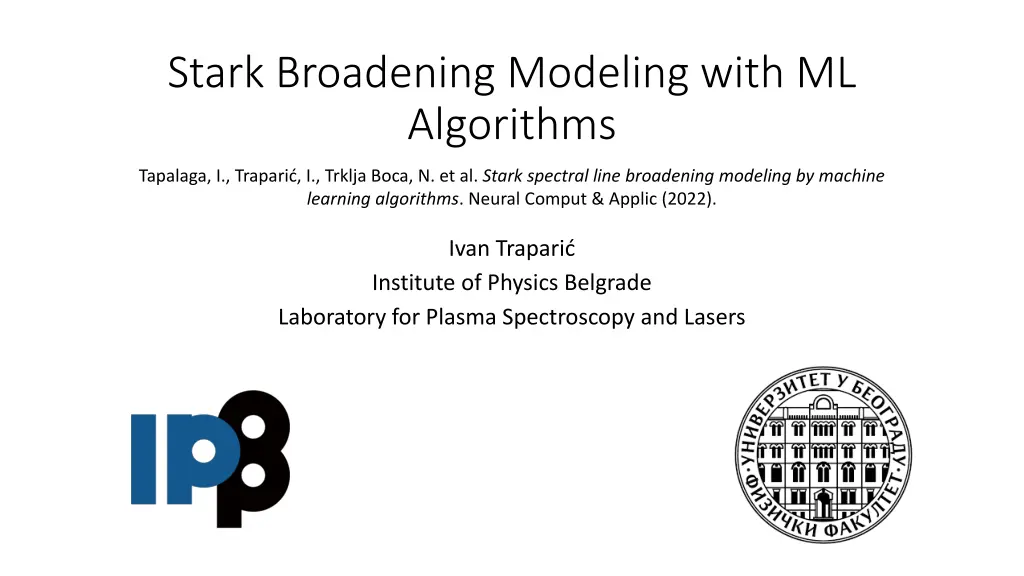
Spectral Line Broadening Modeling Using ML Algorithms in Plasma Spectroscopy
Explore how machine learning algorithms are applied to model Stark spectral line broadening in plasma spectroscopy, from database creation to model selection and results evaluation. The study delves into regularities of Stark effect and predicts plasma parameters with high accuracy.
Download Presentation

Please find below an Image/Link to download the presentation.
The content on the website is provided AS IS for your information and personal use only. It may not be sold, licensed, or shared on other websites without obtaining consent from the author. If you encounter any issues during the download, it is possible that the publisher has removed the file from their server.
You are allowed to download the files provided on this website for personal or commercial use, subject to the condition that they are used lawfully. All files are the property of their respective owners.
The content on the website is provided AS IS for your information and personal use only. It may not be sold, licensed, or shared on other websites without obtaining consent from the author.
E N D
Presentation Transcript
Stark Broadening Modeling with ML Algorithms Tapalaga, I., Trapari , I., Trklja Boca, N. et al. Stark spectral line broadening modeling by machine learning algorithms. Neural Comput & Applic (2022). Ivan Trapari Institute of Physics Belgrade Laboratory for Plasma Spectroscopy and Lasers
Resume Database creation Model selection Results Conculsion 6/23/2023 XIV SCSLSA 2
Database creation - Stark Broadening Regularities study Database was created using two public repositories NIST and Stark b From NIST the ionization energy, principal and orbital quantum numbers, total angular momentum quantum number J for both levels and energy of levels were taken From Stark b the plasma temperature, electron density, emiter, charge of the emiter, and calculated Stark width were taken To check regularities of Stark effect we also added the so-called upper level binding energy defined as ? = ?? ??????. In total we obtained 54235 lines having 14 features 6/23/2023 XIV SCSLSA 3
Data cleaning Outliers: energy of lower level > energy of upper level Dataset selected so that: Ne <= 1e17 cm-3; T<= 150 000 K; upper level energy < 500 eV. Remaining dataset contained 36256 lines. 6/23/2023 XIV SCSLSA 4
Choice of the model Model was created using python public library sci-kit learn. Models considered were: Linear Regression, Decision Three, Random Forest, Gradient Boosting Regressor. Model initialized as Pipeline. First step was data standardization, second step was prediction. Prior to learning the model input data was scaled using standard scaling ???=?? ? ?? ? Hyperparameter tuning was done using GridSearchCV method. Final model, with best score R2 = 0.95 (MAPE = 0.08)was Random Forest with parameters nestimators = 100, while all other parameters were kept at default values. 6/23/2023 XIV SCSLSA 5
Results Regularity studies along Li I sequencies: 2p-nd, 2p-ns, 2s-np, 3d-np, 3p-nd, 3p-ns, 3s-np, 4d-np. ? = ??????? ??? ? Plasma parameters considered were: Ne = 10-14cm-3; 10-16cm-3and plasma temperature was 30 000 K. Stark widths predicted for C II, Al II and Al III and compared with available experimental data. 6/23/2023 XIV SCSLSA 6
Regularities for Ne = 1014cm-3 6/23/2023 XIV SCSLSA 7
Regularities for Ne = 1016cm-3 6/23/2023 XIV SCSLSA 8
Comparison with experimental data (C II) N. Larbi Terzi et al., Mon. Not. R. Astron. Soc. 423, 423, 766 773 (2012) 6/23/2023 XIV SCSLSA 9
Comparison with experiment (Al II and Al III) D. Doji et al., Spectrochimica Acta Part B 166 166 (2020) 105816 6/23/2023 XIV SCSLSA 10
Permutation importance check Feature Importance Ne 5.9 0.2 ni 3.50 0.12 Z 1.04 0.04 Permute each feature 10 times 0.37 0.04 Emitter 0.31 0.03 Calculate decrease in performance li 0.19 0.02 Eupper 0.11 0.02 Higher the decrease, more important is the feature. nf 0.11 0.01 Elower 0.048 0.005 lf 0.029 0.004 J lower 0.029 0.007 J upper 0.021 0.005 Te 0.017 0.003 Ei 0.002 0.001 6/23/2023 XIV SCSLSA 11
New model New model established Model initialized as Pipeline model, same as before. First step data standardization, second prediction. Regressor changed to Transformed Regressor, meaning that the target variable is also scaled. According to the permutation importance, the upper level energy and ionization energy were dropped. R2 improved to 0.98, while MAPE on test data was 10 %. 6/23/2023 XIV SCSLSA 12
Regularities within isoelectric sequence of Be B. Blagojevic et al., JQSRT 61 61, 1999 6/23/2023 XIV SCSLSA 13
Comparison with experimental data Ne = 1017 cm-3 Si II 385.602 nm 3p 4p Al II 559.323 nm 4p 4d C I 132.912 nm 2s22p2 2s2p3 C IV 580.131 nm 3s 3p Cl III 365.695 nm 4s 4p Cu II 254.480 nm 4p 5s Konjevic et al., J. Phys. Chem. Data 31 31, 2002 6/23/2023 XIV SCSLSA 14
Conclusions and future work Potential application of ML algorithms in predicting the Stark width is shown. Solid agreement with experimental data is obtained Regularities within isoelectric sequence also checked, agreement with experiments solid Expand the method to be able to predict Stark widths for highly ionised states Make web application for potential users 6/23/2023 XIV SCSLSA 15
